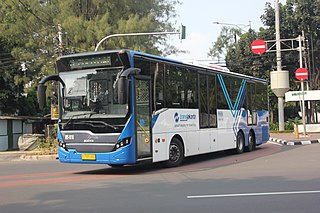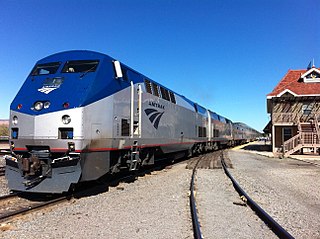
Commuter rail or suburban rail is a passenger rail transport service that primarily operates within a metropolitan area, connecting commuters to a central city from adjacent suburbs or commuter towns. Commuter rail systems can use locomotive-hauled trains or multiple units, using electric or diesel propulsion. Distance charges or zone pricing may be used.

Rail transport is a means of transport using wheeled vehicles running in tracks, which usually consist of two parallel steel rails. Rail transport is one of the two primary means of land transport, next to road transport. It is used for about 8% of passenger and freight transport globally, thanks to its energy efficiency and potentially high speed.

Personal rapid transit (PRT), also referred to as podcars or guided/railed taxis, is a public transport mode featuring a network of specially built guideways on which ride small automated vehicles that carry few passengers per vehicle. PRT is a type of automated guideway transit (AGT), a class of system which also includes larger vehicles all the way to small subway systems. In terms of routing, it tends towards personal public transport systems.

Bay Area Rapid Transit (BART) is a rapid transit system serving the San Francisco Bay Area in California. BART serves 50 stations along six routes and 131 miles of track, including eBART, a 9-mile (14 km) spur line running to Antioch, and Oakland Airport Connector, a 3-mile (4.8 km) automated guideway transit line serving San Francisco Bay Oakland International Airport. With an average of 169,800 weekday passenger trips as of the third quarter of 2024 and 48,119,400 annual passenger trips in 2023, BART is the sixth-busiest rapid transit system in the United States.

Bus rapid transit (BRT), also referred to as a busway or transitway, is a trolleybus, electric bus and public transport bus service system designed to have much more capacity, reliability, and other quality features than a conventional bus system. Typically, a BRT system includes roadways that are dedicated to buses, and gives priority to buses at intersections where buses may interact with other traffic; alongside design features to reduce delays caused by passengers boarding or leaving buses, or paying fares. BRT aims to combine the capacity and speed of a light rail transit (LRT) or mass rapid transit (MRT) system with the flexibility, lower cost and simplicity of a bus system.

AC Transit is an Oakland-based public transit agency serving the western portions of Alameda and Contra Costa counties in the East Bay of the San Francisco Bay Area. AC Transit also operates "Transbay" routes across San Francisco Bay to San Francisco and selected areas in San Mateo and Santa Clara counties. AC Transit is constituted as a special district under California law. It is governed by seven elected members. It is not a part of or under the control of Alameda or Contra Costa counties or any local jurisdictions.

Guided buses are buses capable of being steered by external means, usually on a dedicated track or roll way that excludes other traffic, permitting the maintenance of schedules even during rush hours. Unlike railbuses, trolleybuses or rubber-tyred trams, for part of their routes guided buses are able to share road space with general traffic along conventional roads, or with conventional buses on standard bus lanes.
Various terms are used for passenger railway lines and equipment; the usage of these terms differs substantially between areas:

Rapid KL is a public transportation system owned by Prasarana Malaysia and operated by its subsidiaries Rapid Rail and Rapid Bus. The acronym stands for Rangkaian Pengangkutan Integrasi Deras Kuala Lumpur, which translates to Kuala Lumpur Rapid Integrated Transport Network in the Malay language. Rapid KL, with its 204.1 km (126.8 mi) of metro railway and 5.6 km (3.5 mi) of BRT carriageway, is part of the Klang Valley Integrated Transit System, operating throughout Kuala Lumpur and Selangor's satellite cities in the Klang Valley area.

The station complex of Amtrak's Oakland Coliseum station and Bay Area Rapid Transit (BART)'s Coliseum station is located in the East Oakland area of Oakland, California, United States. The two stations, located about 600 feet (180 m) apart, are connected to each other and to the Oakland Coliseum/Oakland Arena sports complex with an accessible pedestrian bridge. The BART station is served by the Orange, Green, and Blue lines; the Amtrak station is served by the Capitol Corridor service.

Rapid transit or mass rapid transit (MRT) or heavy rail, commonly referred to as metro, is a type of high-capacity public transport that is generally built in urban areas. A grade separated rapid transit line below ground surface through a tunnel can be regionally called a subway, tube, metro or underground. They are sometimes grade-separated on elevated railways, in which case some are referred to as el trains – short for "elevated" – or skytrains. Rapid transit systems are railways, usually electric, that unlike buses or trams operate on an exclusive right-of-way, which cannot be accessed by pedestrians or other vehicles.

Rapid transit in Germany consists of four U-Bahn systems and 14 S-Bahn systems. The U-Bahn, commonly understood to stand for Untergrundbahn, are conventional rapid transit systems that run mostly underground, while the S-Bahn or Stadtschnellbahn are commuter rail services, that may run underground in the city center and have metro-like characteristics in Munich, Hamburg and Berlin which they only have to a lesser extent in other cities. There are also over a dozen semi-metro or Stadtbahn systems that are rapid transit in the city center and light rail outside.

The United States is served by a wide array of public transportation, including various forms of bus, rail, ferry, and sometimes, airline services. Most public transit systems are in urban areas with enough density and public demand to require public transportation; most US cities have some form of public transit. In more auto-centric suburban localities, public transit is generally less frequent and less common. Most public transit services in the United States are either national, regional/commuter, or local.

Public transport is a system of transport for passengers by group travel systems available for use by the general public unlike private transport, typically managed on a schedule, operated on established routes, and that may charge a posted fee for each trip. There is no rigid definition of which kinds of transport are included, and air travel is often not thought of when discussing public transport—dictionaries use wording like "buses, trains, etc." Examples of public transport include city buses, trolleybuses, trams and passenger trains, rapid transit and ferries. Public transport between cities is dominated by airlines, coaches, and intercity rail. High-speed rail networks are being developed in many parts of the world.
Urban freight distribution is the system and process by which goods are collected, transported, and distributed within urban environments. The urban freight system can include seaports, airports, manufacturing facilities, and warehouse/distribution centers that are connected by a network of railroads, rail yards, pipelines, highways, and roadways that enable goods to get to their destinations.
In transport terminology, network length refers to the total length of a transport network, and commonly also refers to the length of any fixed infrastructure associated with the network.

The Oakland Airport Connector is an automated guideway transit (AGT) system operated by Bay Area Rapid Transit (BART) between BART's Coliseum station and Oakland International Airport station. The line is colored on BART maps as the Beige Line. The system is integrated into BART's fare system. The line opened for revenue service on November 22, 2014, replacing the AirBART shuttle bus service that had operated since July 1, 1977. Currently operating between two terminal stations, the system includes provisions for an intermediate third station that may be built at a later date.
A railway infrastructure manager is a rail transport company or body of other type, responsible for maintaining railway infrastructure. The European Union defines it as "any body or undertaking that is responsible in particular for establishing and maintaining railway infrastructure. This may also include the management of infrastructure control and safety systems. The functions of the infrastructure manager on a network or part of a network may be allocated to different bodies or undertakings" This includes mainly railway track and catenary, if the railway line is electrified, and respective command and control systems. It can also include the stations and power supply network. A significant proportion of these companies are state-owned monopolies, responsible for all or most of the railway infrastructure within a given country.

Tempo is a bus rapid transit (BRT) service in Oakland and San Leandro in California. It is operated by AC Transit as Line 1T. The route has dedicated lanes and center-boarding stations along much of the corridor, prepaid fares, signal preemption, and all-door boarding. It is AC Transit's busiest bus route, with an average of 13,615 riders boarding each weekday in Fall 2022.















